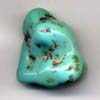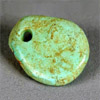- sale
- new items
- lovely beads
- wedding beads
- beads for teens
- for custom order
- newsletter
- recognition
- testimonials
- birthstones
- zodiac signs
- jewelry guide
SHOP BAG
![]() in your bag 0 items
in your bag 0 items
Turquoise is an opaque, blue-to-green, sometimes even yellowish mineral. It is rare and valuable in finer grades and has been prized as a gem and ornamental stone for thousands of years owing to its unique hue. In recent times turquoise, like most other opaque gems, has been devalued by the introduction of treatments, imitations, and synthetics onto the market, some difficult to detect even by experts. The substance has been known by many names, but the word turquoise was derived around 16th century from the French language either from the word for TURKISH (TURQUOIS) or dark-blue stone - PIERRE TURQUIN. This may have arisen from a misconception: turquoise does not occur in Turkey but was traded at Turkish bazaars to Venetian merchants who brought it to Europe.
Turquoise was among the first gems to be mined, and while many historic sites have been depleted, some are still worked to this day. These are all small-scale, often seasonal operations, owing to the limited scope and remoteness of the deposits. Most are worked by hand with little or no mechanization. However, turquoise is often recovered as a byproduct of large-scale copper mining operations, especially in the United States. For at least 2,000 years, the region once known as Persia, has remained the most important source of turquoise, for it is here that fine material is most consistently recovered. Iranian turquoise has been mined and traded abroad for centuries, and was probably the source of the first material to reach Europe. Since at least the First Dynasty (3000 BCE), and possibly before then, turquoise was used by the Egyptians and was mined by them in the Sinai Peninsula, called "Country of Turquoise" by the native Monitu. The Southwest United States is a significant source of turquoise; Arizona, California, Colorado, New Mexico, and Nevada are (or were) especially rich. The deposits of California and New Mexico were mined by pre-Columbian Native Americans using stone tools, some local and some from as far away as central Mexico. China has been a minor source of turquoise for 3,000 years or more. Other notable localities include: Afghanistan, Australia, northern Chile, Cornwall, Saxony, Silesia, and Turkestan.
The pastel shades of turquoise have endeared it to many great cultures of antiquity: it has adorned the rulers of Ancient Egypt, the Aztecs, Persia, Mesopotamia, the Indus Valley, and to some extent in ancient China since at least the Shang Dynasty. Despite being one of the oldest gems, probably first introduced to Europe (through Turkey) with other Silk Road novelties, turquoise did not become important as an ornamental stone in the West until the 14th century, following a decline in the Roman Catholic Church's influence which allowed the use of turquoise in secular jewelry. A common belief shared by many of these civilizations held that turquoise possessed certain prophylactic qualities; it was thought to change color with the wearer's health and protect him or her from untoward forces.




